Protecting wildlife while keeping domestic pets, especially cats, raises contentious and polarising opinions, but we cannot deny the benefits humans have derived from their companion animals over many millennia. When we moved onto our property, in late 2007, our overall aim was to enhance its attractiveness to native wildlife, but we also wanted a few pets. However, we knew how free roaming pets could cause stress to native animals, let alone injury, maiming and death.
Information and advice from a wide range of sources were essential for commencing the task of salvaging our remnant rainforest and revegetating extensive degraded pastures. We got rid of domestic livestock, removed barbed-wire fencing, slashed and sprayed weeds and started to repair soil erosion. We bought rainforest seedlings as tubestock from various suppliers and started growing our own.
As for pets, we decided against dogs for various reasons. While just about every domestic feline is innately hard-wired for hunting, after considerable homework, we settled on a breed of domestic cat we knew would be content living a secure indoor life, separated from wildlife, and would make excellent domestic companions for us.
The effort we invested in choosing cats best suited temperamentally for an indoor lifestyle was essential, as not all cats are happy to stay indoors and some cats, when unhappy, quickly resort to inappropriate behaviour and become difficult to live with.
We considered night-time-only-curfew for cats to be a token gesture, as even well-fed, pampered pet cats will be tempted to catch wildlife, whenever a good opportunity presents. We were also well aware that inappropriate pet selection underlies the enormous stray, feral and shelter populations of cats, leading to euthanasia being their biggest killer in our society.
Having selected our three pets, we made sure they had collars and tags on them, and microchips (to help locate them in case they did escape), were vaccinated, de-sexed and had regular health checks. In addition, while ensuring our house was cat secure, we also sought to give them secure access to fresh air and sunshine, which meant building a cat-proof enclosure. Enclosures can be built in various ways: assemble your own from scratch, buy a kit from a commercial supplier or have one professionally installed.
For maximal outdoor exposure, the walls can be made from wire mesh or reinforced netting. The enclosure can stand free in your backyard, or connect directly to the house by a tunnel or cat- ap door.
We decided to enclose part of our second story verandah, away from dominant prevailing winds, with access to the house via a cat door. The walls comprise wire- strengthened, pre-stretched, low visibility netting (Catmax Clearnet Enclosure) allowing a view. Being at tree-level, the cats can enjoy the temptations offered by wildlife in the garden and surrounds, without causing any damage, and we can sit and relax with them.
We also leash-trained our cats so they can be walked on lawns around our house to get their fill of grass grazing, without bolting suddenly to catch an unsuspecting bird that had been an earlier subject of admiration. Cats sleep 13-16 hours daily,
a need we satisfied by providing safe perches throughout the house and outdoor enclosure where they can get away from each other. We set up “roosts” on top of the fridge, shelves and file drawers and also provided hammocks and marine-carpeted pineboard cat walks under the verandah roof in the Catmax enclosure.
Other necessities for indoor cats include scratch and climbing poles for isometric exercise (which cats need more than dogs), prey-like toys, regularly cleaned litter trays and free access to food and water. We brush them frequently to remove sloughed fur so they don’t have to lick it off or leave it around the house.
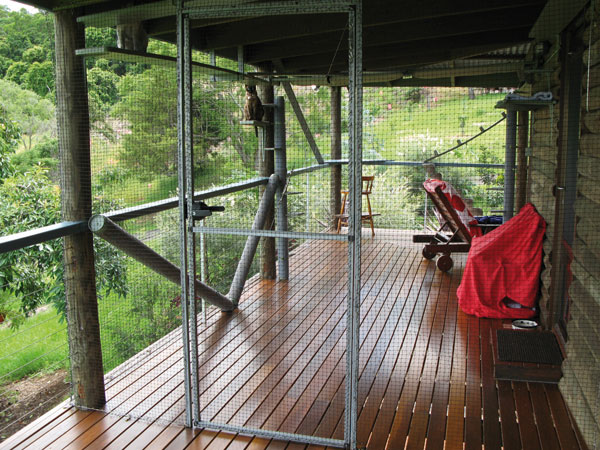
Catmax secure outdoor enclosure on verandah
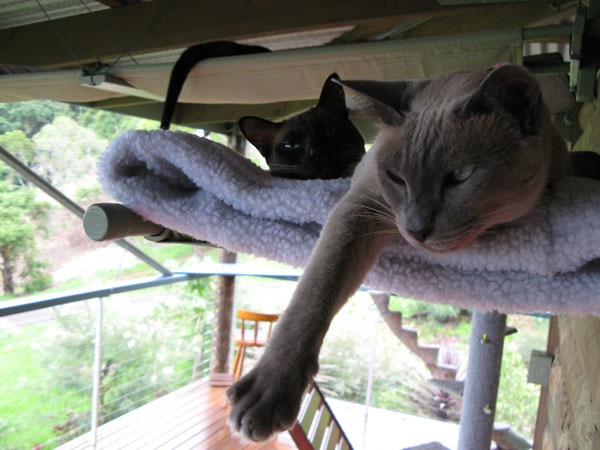
Cats lying around on high hammocks
How has this approach ensured our pet cats are happy but compatible with wildlife?
Firstly, wildlife moves freely around our house, without signs of disturbance. It was thrilling to see a Collared Sparrowhawk sitting undisturbed on the verandah railing within 6 metres of our cats in their enclosure. We are regularly visited by many other bird species, including Pale-headed Rosellas, Australian King Parrots, Rainbow Lorikeets, Sulfur-crested Cockatoos, Galahs, Yellow-tailed Black Cockatoos, Blue- faced Honeyeaters, Spangled Drongos, Noisy Miners, Australian Magpies, Pied Butcherbirds, Pied Currawongs, Laughing Kookaburras, Crested Pigeons, Striated Pardalotes and Pheasant Coucals. Wood Ducks often bring their young to the windows downstairs.
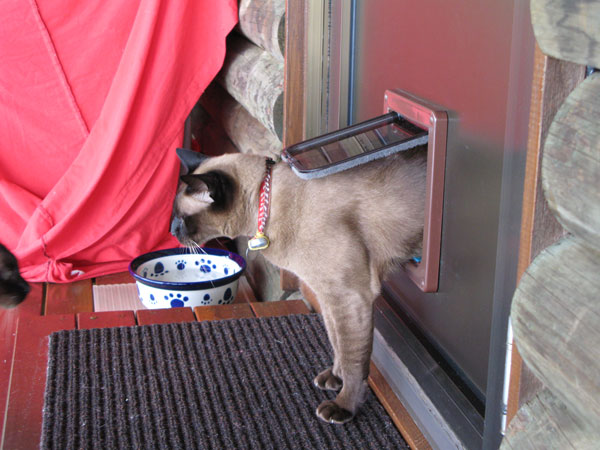
(Above:) Catmax secure outdoor enclosure. (Right:) Collared Sparrowhawk perched on
verandah railing within 6 metres of cat enclosure (raptor identified from our photo by Greg Czechura, Queensland Museum).
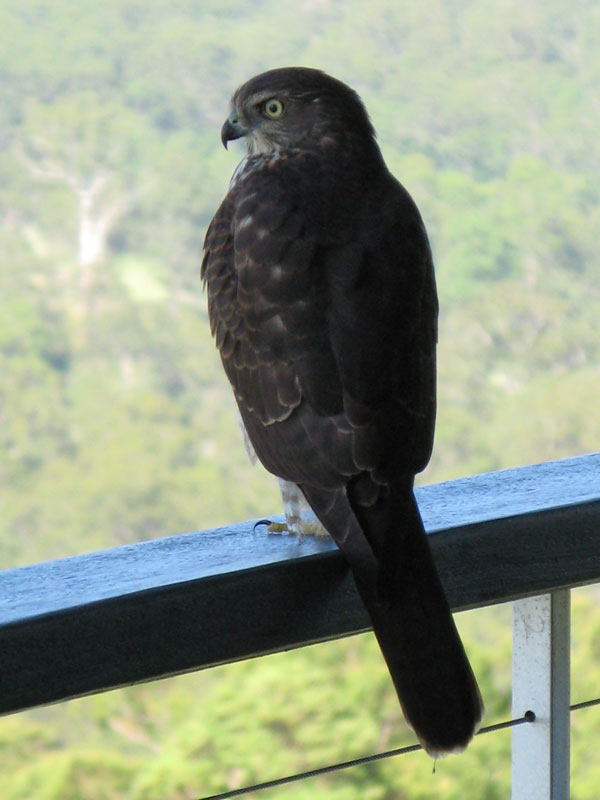
Around the house we also see Swamp Wallabies, and many species of snakes, including Carpet Pythons, Brown Tree Snakes, Green Tree Snakes, Blind Snakes and Red-bellied Black Snakes; lizards including Lace Monitors and Robust Velvet Geckos; frogs, including Bleating, Emerald- spotted, Graceful and Green Treefrogs, Eastern Sedgefrogs, Great Barred-frogs, Striped Marshfrogs and pobblebonks; many insects and arachnids including the uncommon Golden Huntsman.
Secondly, the cats fulfill their hunting instincts by stalking and watching potential prey, without inflicting damage.
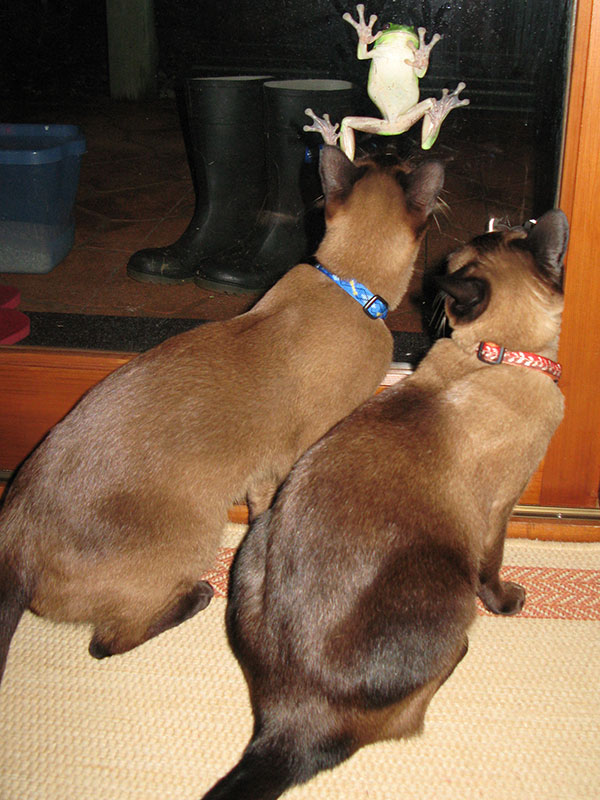
A Green Treefrog (Litoria caerulea) climbing on the outside surface of a glass door, catching insects and watching the indoor feline audience.
Thirdly, the cats are protected from the regular hazards of outdoor feline life, including car strikes, attacks by foxes and by feral and off-leash dogs, attacks by feral and roaming domestic cats (territorial fights can result in lacerational abscesses and transmit feline infectious agents, such as Feline Immunodefciency Virus), envenomation by snakes and paralysis ticks and intoxication from eating baits and Cane Toads.
Our choice won’t be for everyone, and it wasn’t cheap, but we derive great pleasure from seeing our wildlife close up and the population is healthy and growing. At the same time we enjoy the companionship and amusing antics of our pet cats, who are obviously very content. Keeping cats indoors with access to secure outdoor enclosures has parallels with the dog leash laws; in years past, it was normal to see pet dogs roaming freely, but now restraint is integral to responsible dog ownership.
Useful information about options for responsible cat ownership is available at the following sites:
Indoor cat health and behaviour
Consult your veterinarian
www.pethealth.com.au/Page/cat-assimilation-and-moving-cat-pet-pick www.vet.ohio-state.edu/747.htm
Commercial cat enclosure companies (RSPCA endorsed)
www.catmax.com.au
www.catnip.com.au
www.catenclosures.com.au/ www.eftel.com/~oscillot/cat%20fencing%20home.htm
Cat H-style Harness and Leash
We use this very secure, comfortable harness and leash for walking cats because it has easy to use adjustable collar and girth bands, secured by plastic clip buckles. www.lupinepet.com/cat/cats.php
Article and photographs by Paul and Melissa Prociv, Land for Wildlife members, Sunshine Coast.
